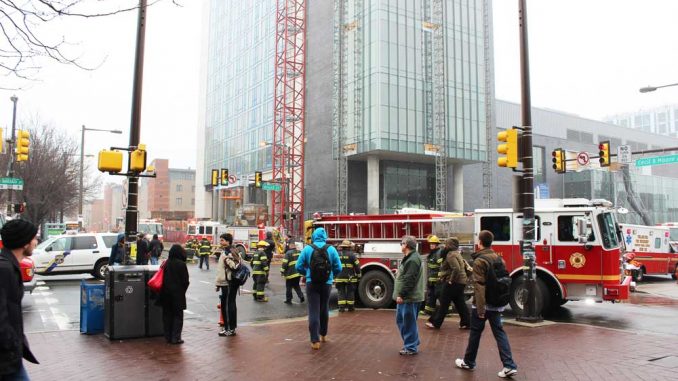
In the weeks following a series of five cases of arson in two days at Morgan Hall in February, which prompted federal agents to investigate the fires, officials have yet to charge anyone in connection with the fires.
Though the social media hype and publicity surrounding the incidents has subsided – even after two small fires were reported in March – the absence of any arrests in the case speaks to the essence of an act that has one of the lowest conviction rates of any major crime.
According to the U.S. Fire Administration, in 2007, only 5 percent to 7 percent of arson offenses resulted in convictions. Specific to arson, conviction is difficult because witnesses to the crime are often rare and motives are hard to substantiate. On top of that, prosecutors must prove the crime was committed and rule out any accidental causes, according to FEMA and the USFA.
It’s extremely difficult to prove arson based on circumstantial evidence, University Fire Marshal John Maule said.
“You almost have to see someone light the fire,” said Maule, who spent 30 years with the Philadelphia Fire Department.
While it’s hard to prove arson, Deputy Director of Campus Safety Services Charlie Leone said the crime doesn’t differ much from other property crimes in how difficult it is to prosecute.
“It’s difficult to prosecute, difficult to find evidence because it’s sometimes destroyed in the fire,” Leone said. “But it’s not unlike other property crimes like burglary or vandalism, where, unless somebody sees it, it’s a little tough to figure out who did it.”
Nobody has been seriously hurt by the fires at Morgan Hall, which have been predominantly small rubbish fires, but damage to the building is hovering around $100,000, said Senior Vice President for Construction, Facilities and Operations James Creedon.
The most significant fire occurred on the building’s 18th floor in an electrical room on Feb. 11.
“That one had probably the most significant potential of threatening and damaging [the building],” Leone said.
One of the issues facing the investigation is the lack of cameras in the building at the time of the fires, Creedon said.
“If you’ve got somebody on camera lighting something [on fire], that’s the best case, but we don’t have cameras throughout the building during construction,” Creedon said. “A lot of times with arson people use an accelerant of some sort, something that’s going to cause it to light up a little bit more. For the most part we haven’t really seen that.”
Creedon said although the fires haven’t caused a delay to construction at the $216 million building, which is slated to open this fall, the fires posed an issue to the workers at the site.
“We were very fortunate that it hasn’t caused any problems,” Creedon said. “It’s not fair to put the men and women there, the people working there, through that.”
The fires are still being investigated by the Bureau of Alcohol, Tobacco, Firearms and Explosives’ citywide task force and is being supplemented by CSS.
ATF Special Agent Steve Bartholomew said the two fires in March are being treated as “separate incidents,” but wouldn’t rule out the possibility that those were lit by the same person or persons who set the five fires on Feb. 11 and 12 in the 27-story high-rise. Bartholomew added that the two fires in March were intentionally set, but caused minimal damage.
There is currently a joint reward of $15,000 being offered by the ATF and the construction manager L.F. Driscoll for information leading to arrests in the case.
Since the fires in February, CSS has increased its presence at the construction site.
“After the arsons, obviously we had to step it up quite a bit, so we partnered with [L.F. Driscoll] and used our resources to assist in a lot of ways,” Leone said.
Even though the incidents are being investigated by a number of agencies, Creedon said he empathizes with the investigators because of the difficulty of the investigation.
“I sympathize. You see them all roll in and you think the federal ATF should be able to identify [the problem] right away, but you soon realize that it’s tough,” Creedon said. “Tough for even the experts.”
Sean Carlin can be reached at sean.carlin@temple.edu or on Twitter @SeanCarlin84.



Be the first to comment